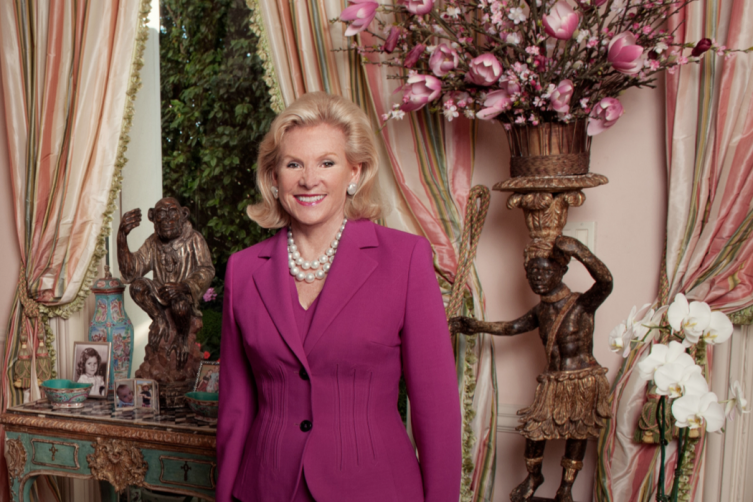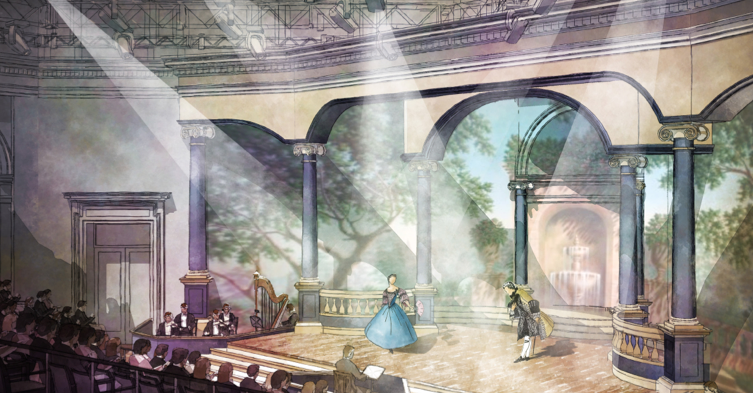One-On-One With Dede Wilsey

Dede Wilsey is not Dede Wilsey. At least that’s not how San Francisco’s philanthropic force sees herself.
“I don’t feel any affiliation with the name Wilsey. I think, well, that’s not me,” she says, as she relaxes on a white couch in an art-filled solarium in her lovely Pacific Heights home, her black Christian Louboutins resting ever-so-gently on a coffee table full of family photos, and Dazzle, one of her three dogs, next to her.
“Well, it’s my last name,” the model of munificence continues. “I sign a lot of checks with it, but I don’t have ‘Wilsey’ children—and Al’s [deceased]… The same with ‘Traina’ doesn’t mean anything to me because John’s [deceased]—even though my children [Trevor and Todd] have that name, that’s not me anymore. It’s a very strange feeling. I can walk by something that has that name, and it means absolutely nothing. I don’t even notice it. Buchanan is the only name that I feel like is me.”
Her father, the late Wiley Buchanan, was President Dwight Eisenhower’s chief of protocol and one-time U.S. ambassador to Luxembourg and Austria; her maternal great-grandfather, Herbert Henry Dow, was the founder of Dow Chemical.
She prattles on. “When people talk about Wilsey Court, I don’t ever really associate that with me, necessarily.”
Her words sound a bit bizarre considering Wilsey Court is in the de Young Museum, nicknamed the “Dede Young” because the queen of fundraising brought in more than $200 million—including $10 million from her own coffer—to rebuild the earthquake-damaged treasure. We chat for a while about the kick she gets out of soliciting money, whether she’s ready to relinquish some of her control over the Fine Arts Museums of San Francisco, where she is in her sixth term as president of the Board of Trustees, as well as if she’ll run for seventh stint, ever marry again and her frequent trips to Washington, D.C., to visit her 97-year-old mother, the grand dame Ruth Buchanan.
It’s no secret how charismatic the iron-willed and well-coiffed Wilsey can be. She loves to talk about herself as much as she does coddle her canines and canvas for cash. In addition to the de Young, she helped raise $3.2 million for Immaculate Conception Academy and $16.6 million for Grace Cathedral. Although she was selected to spearhead the philanthropic effort for the new $1.5 billion University of California San Francisco Medical Center at Mission Bay, she refuses to take credit for that successful $600 million campaign since her priorities shifted to running FAMSF after the death of director John Buchanan in 2011.
The doyenne of donating gave the lead gift on the soon-to-open Diane B. Wilsey Center for Opera, located on the fourth floor of the Veterans Building. San Francisco Opera begins moving into the center—in stages—in December. She’s generously provided to the opera over the many years, both with her late husband Al Wilsey, whom she married in 1981 after divorcing John Traina, and in the last 10 years as the Opening Weekend Sponsor of the season.
Her latest mission is with the San Francisco Ballet—“it’s my favorite art form,” Wilsey enthuses—as chair of the capital campaign’s steering committee, which has a $65 million goal.
Is there no end for this tireless patron of the arts? The truth is, San Francisco benefits greatly because Wilsey has no significant other.
“I’m a widow,” she states, matter-of-factly. “I have nothing but time. I can work 24/7.”
And she practically does. With a staff to handle household tasks and a personal assistant, Wilsey is free to cajole, needle and ask for money for one of her many causes. Try saying no to her about one campaign, and she’ll immediately hit you up for another. Tell her you don’t want your name used, and she’ll suggest you make the donation in the name of your child or dog. “You can’t imagine the dog names on the donor wall at the de Young,” she says with pride. If supervising the 46-member FAMSF board, which oversees both the de Young and the Legion of Honor, is a full- time job as she says it is, she doesn’t mind working two shifts a day when you throw in all of her other obligations.
“You have to say to yourself, am I really busy because I’m keeping busy? Probably. Because you know perfectly well, if you met somebody and you fell madly in love— I’d be on the Riviera right this minute,” she confesses. “I’d find somebody who could take care of this stuff. I keep myself really, really busy so I don’t notice that I’m alone.”
While indifferent about Wilsey Court, she is particularly fond of the de Young, itself, because it proved to be her salvation when Al’s health worsened. He died on a Friday, and three days later, Wilsey stood before the Board of Supervisors and gave the speech of her life in hopes of getting the necessary building permits. She talks about how she had never been by herself from the time she was 18, when she met Traina, until his death because “the minute Al died, John was right there,” she recalls. “I was never alone.”
While she says there is no great motivation to marry, she quickly adds, perhaps to amuse herself, “I would live with somebody if I could figure out where I could put those clothes that are in the closets now. God, where would you move somebody in? Tricky business—you have to get rid of a lot of stuff… I think that all those problems solve themselves when you meet the right person—and I haven’t done that.”
That’s especially good news for San Francisco’s cultural institutions. Wilsey’s term as president of the board of FAMSF, which lost its director when Colin Bailey returned to New York earlier this year—Richard Benefield is the acting director— runs through October 2016. Asked if she’ll seek a seventh term, she looks straight at the questioner, bites her bottom lip and waits a couple of seconds before replying.
“I wouldn’t answer that now,” she finally responds. “I’ll have to see how I feel. I think it’s good to change people.”
She wouldn’t mind seeing the structure changed, perhaps going back to the old days when there was both a president and a chairman—a position she held from 1996 to 1998 before she became president, and the chairman role was eliminated— at her recommendation. “I thought, I don’t need another person to talk to; it’s just more work,” she recollects.
Now, “I’m delighted to relinquish—delighted,” she assures, repeating the word to make her point. “I’ve tried to relinquish on several occasions, but I couldn’t find anybody who would take the job, so I said, not a chance.”
Today, she says the board is full of qualified people whom would make a terrific president—if they have the time, she quickly adds.
“I’m the past and I’m the present, but they’re the future,” she says. “I need to come up with a way that these young people can be the leaders without feeling put upon because they have young kids to take care of, or businesses they’re starting.”
For her, the de Young is a fulltime job that she works at daily, including the weekends, which she usually spends at her Rutherford home. Every six weeks or so, she journeys across the country to see her mother.
“She’s got her marbles,” Wilsey brags, “but it’s harder to have a conversation with her because she’s not doing anything.”
Wilsey, however, has never been accused of doing nothing; just the opposite. Over the years, she’s been faulted for flaunting her power and being controlling.
“I’m trying to delegate, which has not been easy, always, because I didn’t have the people to delegate to,” she rationalizes. “But, I have been very careful to choose people now whom I can delegate to with the greatest of confidence and not worry at all once they’re in charge of something. I could go do something else—and it’s a wonderful feeling.”
Wilsey has nothing but praise for the new board and its young committee chairs, the majority of whom are in their 40s and early 50s. She’s getting a kick out of working with them.
“They’re so bright and they’re very innovative,” she gushes. “Their attention span, in many cases, is short, which is good because it keeps you on your toes. You’ve got to keep moving, keep thinking of something new. And if they suggest something, you need to implement it right away, because they’re not going to wait .”
The de Young recently released an app that takes advantage of Apple’s indoor positioning technology—the first museum to do so—to improve the visitor experience. New programs include the de Youngsters, whose goal is to make the de Young and the Legion of Honor more family-friendly, and drop-in art classes for children on Saturdays. There’s talk of doing a pop-up museum in SoMa, the heartland of San Francisco’s techies.
Whereas Wilsey used to criticize tech’s young billionaires for not being charitable enough, she’s softened her words—to an extent. While, on one hand, she calls the entrepreneurs “very, very bright,” she goes on to say that they don’t know whether they really are wealthy because their money is on paper—not in the bank.
“They haven’t learned philanthropy yet—they’re really not sure how wealthy they are. So I think we have to cut them some slack while they figure all this out. Their areas of interest are pretty limited to science, which is wonderful, medicine, [and] children. Unfortunately for people like me, it’s not what I call ‘culture.’ The problem is, you can’t have a civilization without culture. I’m hoping that they get interested in the symphony, opera, ballet, the museums and art. They probably have more of an inclination for the contemporary art, but they’re not donors yet— and they’re not really collectors yet. But, I think the time will come,” she pauses for a while, then adds wistfully, “hopefully.”
That doesn’t mean she’ll quit trying to work her fundraising magic, which brings her such joy. She reminisces about asking a man to be on a committee that, in a rare case, required a $2 million donation by its members. A couple of days later, the man relented upon the condition that Wilsey not tell his wife because he says his better half had no idea that he had $2 million.
“I just cracked up,” Wilsey recalls. “A week doesn’t go by that I don’t have some really funny experience where I say to myself, this makes it worthwhile. I’m having fun, because when it stops happening, then you need to find something else to do.”













